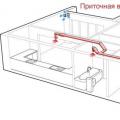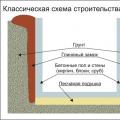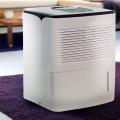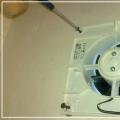The microclimate in the house and comfortable living in it largely depend on a properly designed ventilation system in all its premises. It is especially important to timely clean the air in the basement. Many people pay little attention to this during construction, but in vain. Good ventilation of the basement of a private house will not only help protect against the appearance of mold and fungus on the walls, but will also significantly extend the life of the building. In addition, air circulation will allow you to save things and products in it.
Types of ventilation in the basement of the house
Maintaining normal temperature and humidity parameters in the house is possible only with the proper creation of air exchange in it. This is done by arranging a system of ventilation ducts, including in the basement.
There are two types of ventilation in the basement of a private house:
- forced
- natural
Each system has its own characteristics and in order to make a choice, it is necessary to have an idea of both the advantages and disadvantages of each of them.
Forced ventilation
This system is most often used in large houses, where there is a need to supply fresh air to other rooms. Its purchase and installation require significant costs, so not everyone can afford such a luxury.
Forced ventilation of the basement of a private house includes the following elements:
- ventilation ducts
- furnace blower or air conditioner
- air outlet
- air intake
- air diffusers
- flow summation tees
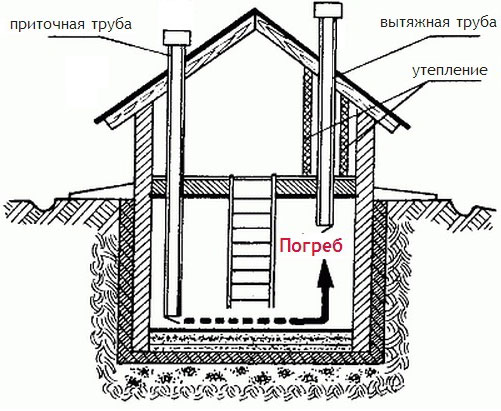
This ventilation works in the basement as follows. Outdoor air is blown into the system by a fan, if necessary, it is filtered. Then, depending on the need, it is cooled or, conversely, heated. Then the fan is fed through the air ducts into the premises.
The main disadvantage of this type of system is its high price and complex installation. The main advantage is its independence from weather conditions, as well as the ability to regulate air exchange, and of course, the quality of the air supplied to the premises.
This system has been known since ancient times and to this day it does not lose its popularity. Mainly due to the simplicity of the design and the fact that its device does not require significant cash costs.
Natural ventilation of the basement of a private house consists of just a few simple elements:
- products
- exhaust channel
- supply channel
The operation of the system is based on the existing temperature difference between the outside and inside the basement, which determines the movement of air. This simple natural phenomenon provides an extract from the basement and a fresh flow from the street. In this case, there is a direct dependence of the traction force on weather conditions, which can strengthen or weaken it. Features of the basement ventilation of this type are the simplicity of its arrangement. The disadvantage is not quite complete air exchange and the dependence of air circulation on external natural factors.
Whatever the basement ventilation, its carefully thought-out arrangement is a guarantee of long-term use of the building for both permanent and seasonal residence. To store food or furniture, it is necessary to adapt certain areas of the room.
In most cases, ventilation in the basement of a private house consists in the movement of air through a system of shafts or pipes, its main goal is to ensure optimal humidity and temperature indicators for a given room, as well as maintaining a general air exchange cycle throughout the house. The basement ventilation system can be based on natural processes and include only exhaust and supply pipes. Another option is the arrangement of forced ventilation based on a supply device, exhaust ventilation, and a system of ventilation ducts.
Elements of natural ventilation in the house
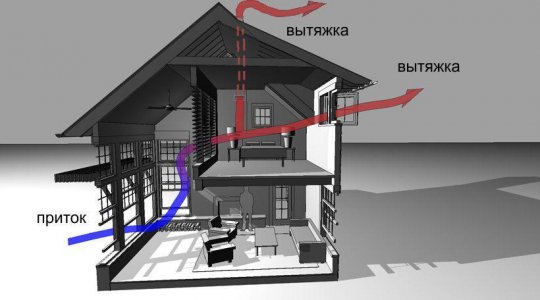
Effective natural ventilation of the basement in the house implies the presence of the following components:
- Exhaust and supply channels;
- Produh.
Such ventilation largely depends on natural phenomena and seasonal climatic conditions, and the intensity of air exchange is not always sufficient to maintain optimal indoor conditions (but this depends on the purpose for which the basement is used).
Natural basement ventilation in the house
The main reason for the popularity of natural basement ventilation in the house is its cheapness, but the simplicity of the design plays a significant role in the choice. The motive force for the functioning of such a system is the temperature difference in the basement and on the street, it is because of this that the movement of air flows. Thus, fresh outdoor air replaces the exhausted air from the premises. Here one should take into account the influence of the wind, because it can both weaken and strengthen natural draft.
Components of a forced ventilation system
For this ventilation system, elements such as:
- Pressure air conditioning or furnace unit;
- Ventilation ducts, air intakes, air outlets;
- Diffusers for air supply;
- Flow summation tees.
Forced ventilation is able to provide high-quality and controlled air exchange, it does not depend on external climatic conditions. But at the same time, the disadvantages include the complexity and high cost of equipment and installation.
Features of forced ventilation
This ventilation in the basement of a residential building works on the basis that air from the street enters the building through fans, if necessary, it is cooled or heated along the way, filtered, then the same fans supply it directly to the room. Forced ventilation of the basement in the house is optimal for large buildings, where, in addition to the basement, air exchange is also provided in living rooms.
System coordination
To check the quality of ventilation, it is necessary to regularly inspect the exhaust and supply devices, making sure that the air is actually supplied and removed. It is recommended to install in the basement alcohol thermometer, as well as a psychrometer that determines the relative humidity. If the room is used for people to stay, the optimum air temperature is within 16-21 ° C with a humidity of 50-60%. For the economic purpose of the basement, the humidity should be (maximum) 80-90%, and the temperature should be 1-10 ° C.
If, when examining the ventilation of the basement in the house, deviations in the microclimate are found, first of all, the ventilation flaps are adjusted, then the room is thoroughly ventilated. If the permissible level of humidity is exceeded, a box filled with materials that can absorb moisture is placed in the basement - coarse salt, sawdust, quicklime. Regular disinfection of the basement is also recommended.

